#Heidelberg West
Explore tagged Tumblr posts
Text

Mologa Rd, Heidelberg West (Melbourne).
43 notes
·
View notes
Text
youtube
Heidelberg, 1809
#heidelberg#germany#baden württemberg#neckar#south west germany#heidelberg castle#germania#germanic#karlsruhe#eintracht frankfurt#frankfurt am main#frankfurt#Youtube
0 notes
Text
It looks as if the pace of evolutionary change accelerated all across the Old World after 800,000 years ago as ape-men entering the cold north encountered wildly different climates where random genetic mutations could flourish.*
*That said, Heidelberg Man did live in Africa as well as Europe. Some paleoanthropologists envisage a European origin followed by a spread back into Africa, but others assume that Heidelberg Man, like Homo habilis and Homo ergaster, evolved in Africa in response to local climate changes, then spread north. Bones rather like Heidelberg Man's have also been found in China, but that evidence is more disputed.
"Why the West Rules – For Now: The patterns of history and what they reveal about the future" - Ian Morris
#book quote#why the west rules – for now#ian morris#nonfiction#evolution#acceleration#old world#ape man#cold#north#climates#genetic mutation#flourishing#adaptation#heidelberg man#africa#europe#paleoanthropology#homo antecessor#homo habilis#homo ergaster#china#evidence#disputed#bones
0 notes
Text
By 600,000 years ago, when Heidelberg Man came onto the scene and Peking Man ruled the roost at Zhoukoudian, there were definitely different species of Homo in the Eastern and Western parts of the Old World: in the East the small-brained Homo erectus and in the West the larger-brained Homo antecessor and Heidelberg Man.*
*And, of course, an unknown number of hominin species like the Flores hobbits that died out without leaving modern descendants. Another new species was identified in the mountains of central Asia in 2010, and was predictably labeled "the yeti."
"Why the West Rules – For Now: The patterns of history and what they reveal about the future" - Ian Morris
#book quotes#why the west rules – for now#ian morris#nonfiction#heidelberg man#peking man#zhoukoudian#the east#the west#old world#homo erectus#homo antecessor#flores hobbits#central asia#10s#2010s#21st century#the yeti#archaeology
0 notes
Text
by William P. Barr
Reading the report issued last month by Columbia University’s Task Force on Antisemitism, one could be forgiven for thinking that it describes the University of Heidelberg circa 1933. It contains accounts of observant Jews being harassed and assaulted, and open calls for the murder of Jews. But no, this is not Nazi Germany. This is the Upper West Side of Manhattan in 2024. There—in one of the nation’s most elite enclaves of higher learning—the oldest hatred is alive and well, gussied up in academic robes.
The admittedly “serious and pervasive” antisemitic incidents detailed by the report are disturbing. Even more troubling is the extent to which Columbia faculty and administrators were complicit in the problem. One instructor kicked off a class in the Master of Public Health program with a discussion of the Jewish “capitalists” who “laundered” their “dirty money” and “blood money” through donations to the university. Others silenced Jewish students in class discussions of the Holocaust and Israel. Still others moved class sessions and office hours to Columbia’s “Gaza Solidarity Encampment,” where Jewish students were routinely threatened and physically attacked.
For their part, campus demonstrators made no attempt to conceal their hatred of Jews. In fact, they made a public spectacle of it. A video cited by the report shows demonstrators stealing an Israeli flag from a Jewish student and assaulting him as he tried to stop them from setting it on fire. It shows demonstrators repeatedly shouting “Go back to Poland” at Jewish students as they walked across campus. One leader of the encampment proudly boasted, “Be grateful that I’m not just going out and murdering Zionists. . . I feel very comfortable calling for those people to die.” Still, the same university that offers hours of training on “microaggressions” refused to acknowledge decidedly macro-aggressive attacks on Jews.
While all this was happening, administrators either minimized or denied the problem. One member of the Office of Diversity told a student that if the antisemitic incidents she observed made her feel unsafe, she should leave campus. Another administrator told individual students that they were the “only student” who had complained about antisemitism before referring each for mental health counseling.
The gaslighting is astonishing. Moreover, the report’s key recommendation—more training on what constitutes antisemitism—misses the point.
Antisemitism isn’t borne of ignorance at Columbia. Antisemitism is taught at Columbia. Discrimination—now reconceptualized as “intersectionality”—has become the ideological touchstone of the university. It is the subject of training programs, celebrated in academic centers, studied in labs, and baked into departmental mission statements. Under this theory, the world is divided into oppressor and victim classes based on racial, ethnic, and gender identity. And in this system of power and subordination, Jews are the ultimate oppressors. As one Columbia student leader put it, “white Jewish people are today and always have been the oppressors of all brown people.”
So the problem is not, as the report suggests, an “absence of clarity” about what constitutes antisemitism. It’s that antisemitism now lies at the ideological heart of the university, smuggled in through postmodern critical theory. It has been nurtured in faculty lounges and classrooms for decades. Now it is on public display for the entire world to see.
This hatred is a danger to all members of the Columbia community, as it will not—and has not—stopped with Jews.
In April, an angry mob consisting primarily of Columbia students, alumni, and even faculty, overran the university’s historic Hamilton Hall in the name of “intifada.” Four janitors were working in the building at the time, cleaning up after students and faculty. The rioters held two of the men, one African American and the other Latino, against their will and physically assaulted them. (My law firm represents the two workers.)
All of this darkly mirrors the violent convulsions that wracked Columbia during the late 1960s, when I was an undergraduate there. Then, as I recount in my recent memoir, it was Students for a Democratic Society that was calling for a revolution. Mainly white and affluent, the demonstrators seemed to have done pretty well for themselves under the existing democratic system. But what they lacked in intellectual coherence, they more than made up for in violent zeal. They took over buildings, rioted, and provoked violent confrontations with the police, all while campus administrators, with a few notable exceptions, remained supine.
By the time the university was forced to take action against the rioters, it was too late. The message had been sent. Moderates, conservatives, and the politically undecided chose to pursue their education elsewhere. Radicals and revolutionaries were welcome on the Columbia faculty. And the very mission of the university changed from the pursuit of truth and knowledge to activism and social transformation.
The antisemitism that is convulsing Columbia is the consummation of the ideological drift and mission creep that began at the university in the 1960s. What was initially a crude cry for revolution in the riots of 1968 now finds expression in the academic jargon of intersectionality. But violence is the inevitable end of a theory that views our democratic institutions as systems of subordination. And antisemitism is the impulse that is unleashed by the intersectional taxonomy of oppressors and victims.
It will take more than a cleanup crew to remove the stain of antisemitism at Columbia. It will take principled leaders with moral courage and ramrod spines, both of which seem to be in short supply. In the absence of those leaders, the victims of discrimination will have to rely on our legal and judicial institutions to protect the civil rights that Columbia University has once again surrendered to a baying mob.
#columbia university's taskforce on antisemitism#columbia university#antisemitism#gaza solidarity encampment#gaslighting
30 notes
·
View notes
Text

Excerpts from Herbert Tobias entry on Wikipedia:
Tobias was a German photographer best known for his fashion photography during the 1950s. He also drew critical praise for his portrait studies, his photographs of Russia during World War II and his homoerotic pictures of men.
In 1942 Tobias was drafted into the German Nazi army and was sent to the Eastern Front. Shortly before the end of the war he deserted and was captured by the Americans on the Western Front. He was released at the end of 1945.
In 1948, while staying in Heidelberg he began a relationship with a civilian employee of the American Forces of Occupation. In 1950 both men were denounced under § 175 of the German Criminal Code. They moved to Paris.
In Paris Tobias worked as a retouched for German photographer Willy Maywald who introduced him to the fashion world. In 1953 Tobias' first published photos appeared in Vogue. In the same year, after resisting arrest during a police raid on a gay establishment, he was thrown out of France and returned to Heidelberg.
Soon his fashion photographs began to appear in West German magazines. And November 1953, out of over 18,000 entrants, he won first prize in a highly lucrative competition by Frankfurter Illustrierten Zeitung.


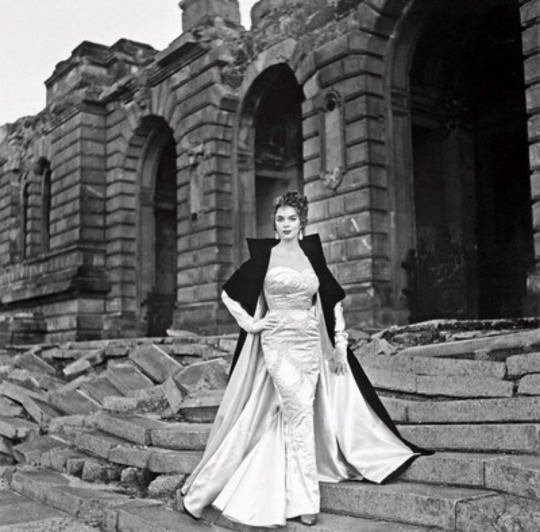
Through publication of his work in many high-class magazines Tobias had become, by 1956, an established figure in West German fashion scene.

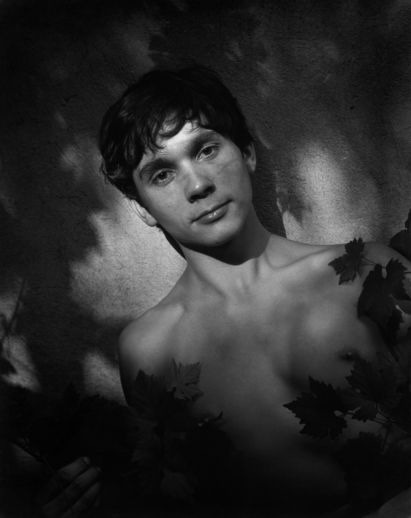
During the 1960s, Tobias style fell out of favor in Fashion magazines. But in 1972 he found a new avenue for his photographs - various gay and pornographic magazines.


By 1981, with some high profile exhibitions of his work in Amsterdam and Berlin, Tobias working on a book with a collection of his nudes.
Tobias became seriously ill in February 1982 and died in August of the same year. He was one of the first high-profile victims of AIDS in Germany. He was buried in Altona Cemetery in Hamburg. In 2007 his grave site was declared an Ehrengrab ("grave of honour") by the Hamburg Senate.
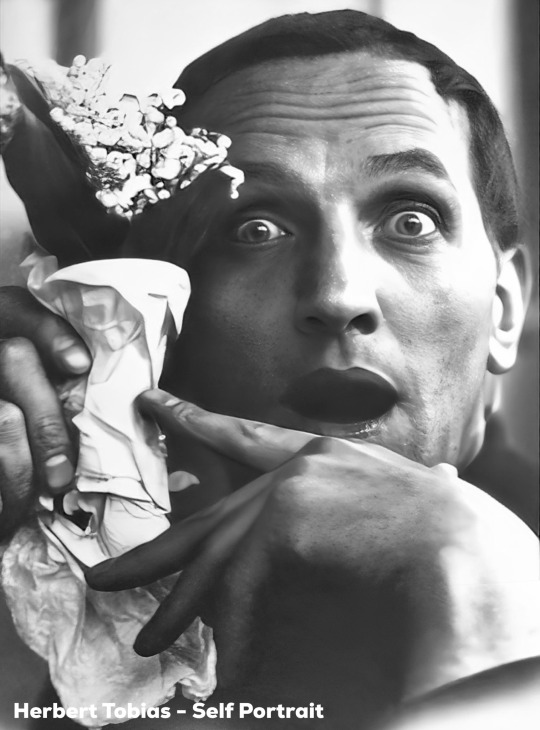
#Ehrengrab#gay icons#Herbert Tobias#German photographer#fashion photography#vogue#homoerotic#German Criminal Code#AIDS#resisting arrest
32 notes
·
View notes
Text
On the plane I sat next to Christine. We didn’t talk for most of the nine hours. She ordered wine and the vegetarian options of the meals. She was in her seventies I guess, long messy curly grey hair, a small woman, wearing work out pants. When we were starting the process of landing I eventually started to read a bit in my Sally Rooney book. I didn’t read much, turbulences distracted me. She eventually asked me “how are you liking it?”. I told her how I was cringing a bit and she proceeded to jump onto this and told me this whole story of travelling to Ireland for a conference and feeling the need to buy a book of hers. How she never read much during her studies but when she was working she made sure to. How reading that book “didn’t do it for her” but she told herself that she just doesn’t get it and that she just was too old. So when she saw a young person reading it she had to approach me about it. She said she wasn’t around many young people. She grew up in Munich until she was six, lived in West Berlin at some point, used to be an epidemiologist (I asked “Oh so with skin?” because I understood ‘dermatologist’…). About Germany she said she liked that we are into herbal medicine, she recently visited that pharmacy museum in Heidelberg (my ex visited when he was in the country, it’s pretty cool). She was such a cool hippy woman, living in Manhattan now. This story doesn’t have a point. I like older quirky women like her and I love when they show interest in me and tell me their life story.
13 notes
·
View notes
Text


On November 7th 1619 Elizabeth Stuart was crowned Queen of Bohemia.
Elizabeth was the eldest daughter of James VI, and Anne of Denmark. She was thus sister to King Charles I and cousin to King Frederick III of Denmark.
Born in at Falkland Palace, Fife,on 19th August 1596, she was named Elizabeth in honour of the then-ageing English Queen, Elizabeth I, who had remained childless. Her older brothel was Prince Henry, of her other siblings, Charles would however go on to inherit the throne.
To all intents and purposes, Elizabeth had a happy upbringing at Linlithgow Palace, one of the grandest of Scotland’s royal residences, and one of my favourite places to wander around.
In 1603 her father James succeeded Elizabeth I to the English throne. Elizabeth was handed over to the care of Lord and Lady Harrington and took up residence at Coombe Abbey, Warwickshire.
Lord Harrington indulged her passion for nature, and in a secluded wilderness at the end of the park arranged the construction of a number of little wooden buildings in all the different orders of architecture which housed paintings and stuffed animals. He also established an aviary and a miniature menagerie (she continued to collect various animals throughout her life) which was later expanded to include meadows stocked with the smallest breeds of cattle from Jersey, Shetland and the Isle of Man. Elizabeth referred to her miniature world as ‘her Territories’ and ‘her Fairy farm’ and she engaged a pauper family as keeper of her birds and beasts.
Elizabeth idolised her older brother - they shared a love of life which eluded the sickly Charles, four years younger than his sister. Her letters to her brother Henry reveal a deep affection and and mutual respect. In 1605 she writes ‘My noble brother, I rouse you from sleep to remind you that I am your most humble servant, and desire above all that I might have the pleasure of remaining in your good graces and your best loved sister.���
Henry’s sickness and death on November 6, 1612, in the midst of Elizabeth's betrothal celebrations devastated her. It is not mentioned in Elizabeth’s letters of 1612 or 1613, a silence that suggest great mourning however her strength of character can be demonstrated by her attempts to gain access to Henry’s isolated sick room. Disguised as a country girl, she tried several times to gain admittance to Henry but was recognised and turned back. Henry’s last words were his sister’s name.
By the age of 12 Elizabeth’s political value was such that a member of the influential Hapsburg family, King Philip III of Spain, put himself forward as a eligible suitor. While Queen Anne relished the opportunity of a glittering Spanish throne, James’ mind was set on a Protestant:Frederick V, Prince Palatine of the Rhine in the Holy Roman Empire, frequently known as the Palsgrave.
Luckily for Elizabeth, Frederick was her own age, handsome, athletic, of a winning personality and generous. In many ways he resembled her brother Henry, with whom he developed a deep friendship. Frederick could not fail to love Elizabeth although she was initially more reserved.
On Valentine’s Day 1613, a spectacular wedding ceremony took place in the Royal Chapel at Whitehall Palace in London. At the time of their marriage, Elizabeth and her young groom Frederick V were destined to achieve international power and influence. However, by 1621, Elizabeth was in exile, destined to be remembered as the ‘The Winter Queen’, a derogatory epitaph that reflects the short duration of her rule in Bohemia, with her union with Frederick deemed a political failure.For almost two months, the young couple were feted and feasted in London before setting out on their journey to their new home in Heidelberg, in south west Germany. Elizabeth and Frederick eventually reached the Palatinate and its capital in Heidelberg situated on the banks of the river Neckar.
Six years later, in late 1619, Frederick and Elizabeth were crowned King and Queen of Bohemia (today part of the Czech Republic) at the invitation of the Bohemia Confederacy to prevent a Catholic incumbent ascending to the throne. Barely a year after receiving the crown, the couple were defeated at the Battle of the White Mountain, and driven from their court in Prague and deprived of all their Palatine lands by the Hapsburg Holy Roman Emperor Ferdinand II, events which led to one of the longest and most destructive conflicts in human history:The Thirty Years War.
During their separations whilst Frederick was on campaign, the couple wrote to each other three or four times a week, sometimes even twice in one day. Frederick describes Elizabeth as his ‘only heart’, he ‘kisses her mouth a million times in imagination’.
Frederick died unexpectedly from the plague at Mainz while on perpetual military campaign in 1632. So long as she lived, Elizabeth’s rooms were draped in black, and in memory of Frederick special days were set apart for fasting. She later wrote ‘though I make a good show in company, yet I can never have any more contentment in this world, for God knows I had none but that which I took in his company, and he did the same in mine.’
Elizabeth lived on in the Dutch Republic for a further 30 years, in voluntary exile, returning to England in 1661, a year before her death and a year after the restoration of her nephew, Charles II.
It is through Elizabeth’s daughter, Sophie, the Hanoverians line was established.
8 notes
·
View notes
Text
Pamela Salem 1944-2024
Friday, 23 February 2024 - Reported by Marcus
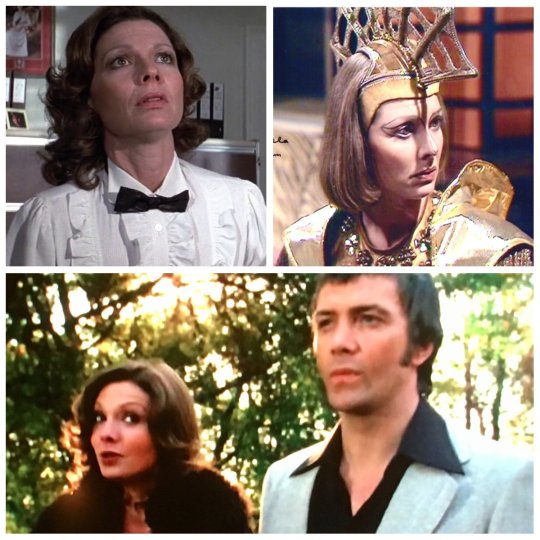
The actress Pamela Salem has died at the age of 80.
Pamela Salem appeared in three Doctor Who stories. In 1977 she played Toos in the acclaimed Fourth Doctor story The Robots of Death. Her voice was used as one of the voices of Xoanon in the previous story, The Face of Evil. She returned to the series in 1988 playing Rachel Jensen alongside the Seventh Doctor in Remembrance of the Daleks. She later reprised her role as Jensen in the Big Finish audio spin-off series Counter-Measures and 1963: The Assassination Games.
Pamela Salem was born in Bombay, India, and educated at Heidelberg University in Germany and later at the Central School of Speech and Drama in London, England.
Film work included the role of Miss Moneypenny in the 1983 James Bond film Never Say Never Again, starring Sean Connery.
Other television appearances included parts in EastEnders, where she played mafia affiliate Joanne Francis, and as the evil witch Belor in ITV's Into the Labyrinth.
Other television guest appearances have included roles in the third episode of Blake's 7, The Onedin Line, The Professionals, Howards' Way, Ever Decreasing Circles, Tripods and All Creatures Great and Small
She later moved to the United States where she continued her career in series such as Magnum, P.I., Party of Five, ER and The West Wing where she played a British prime minister.
[Source]
23 notes
·
View notes
Text
US Empire, Israeli Settler Colonialism & "Reconfiguring" the Region? - Fathi Nimer & Abdaljawad Omar
youtube
In this episode Fathi Nimer and Abdaljawad Omar will both return to the show to discuss some of the most recent developments in the increasingly regional war Israel and the United States are conducting in the Middle East. We will discuss recent developments including the assassination of Sayyed Hassan Nasrallah, the pager attacks, the ground invasion of Lebanon and Iran's retaliatory strikes on Israel's airbases. We will also discuss the increasing interest in the west of supporting Israel in trying to conduct a regional war against Iran, Lebanon, and perhaps Syria.
Fathi Nimer is Al-Shabaka’s Palestine policy fellow. He previously worked as a research associate with the Arab World for Research and Development, a teaching fellow at Birzeit University, and a program officer with the Ramallah Center for Human Rights Studies. Fathi holds a master’s degree in political science from Heidelberg University and is the co-founder of DecolonizePalestine.com, a knowledge repository for the Palestinian question. Fathi’s research revolves around political economy and contentious politics. His current focus is on food sovereignty, agroecology, and the resistance economy in Palestine.
Abdaljawad Omar is a writer, analyst, and lecturer based in Ramallah, Palestine. He has written extensively in Arabic. In English Abboud has contributed to Electronic Intifada, Mondoweiss, and Ebb Magazine among other outlets.
Both are have been guests on multiple episodes of MAKC
Support our work at Patreon: millennialsarekillingcapitalism
7 notes
·
View notes
Text

Cress Williams (July 26, 1968) is an actor, known for his roles in Prison Break and Close to Home. His most recent roles include Mayor Lavon Hayes on Hart of Dixie and Black Lightning. He is known for his recurring role as Terrence “Scooter” Williams on Living Single and as Inspector Atwon Babcock on Nash Bridges.
He was born in Heidelberg, Baden-Württemberg, West Germany, to American parents. He took courses at Fullerton College and earned a BA in theatre from UCLA.
He acted in a 1990 Fullerton College production of Othello. He acted in another production in the same year at Fullerton College called Red Noses.
He has appeared on many TV series since 1994, including Star Trek: Deep Space Nine, Beverly Hills, 90210, NYPD Blue, Lois & Clark: The New Adventures of Superman, JAG, Nash Bridges, Providence, Law & Order: Special Victims Unit, Veronica Mars, The West Wing, Close to Home, ER, and Grey’s Anatomy. He portrayed Talak’talan, a Jem’Hadar leader in the Star Trek series, in a Star Trek: Deep Space Nine episode “The Jem’Hadar”. He joined the Prison Break cast by playing The Company’s assassin, Wyatt Mathewson. He appeared in the final season of Friday Night Lights as Ornette Howard. He starred in Hart of Dixie as former football star turned mayor, Lavon Hayes.
He has ventured back into adaptations of DC Comics: As main character Jefferson Pierce / Black Lightning on Black Lightning (2018-21), which was integrated into Arrowverse’s prime Earth during Crisis on Infinite Earths, and as John Henry Irons in The Death of Superman and its 2019 sequel, Reign of the Supermen. After his Black Lightning series concluded, he reprised the role on The Flash at the start of its eighth season as part of its “Armageddon” event.
He married actress Simbi Khali (2000-11). The couple had two children. He married his girlfriend Kristen Torrianni (2013). They have two children together. #africanhistory365 #africanexcellence
2 notes
·
View notes
Text



The "West-Eastern Diwan" by Goethe - A bridged beauty between Occident and Orient. Published by Prof. Dr. Heinrich Düntzer, Berlin and Stuttgart, 1878.
It is said, that Goethe used the "oriental mask" to cover his pantheistic ideas, speaking trough the lips of the newly translated poets. Next to the Hafez' poems, which where published and translated by the orientalist Joseph von Hammer, other literal and scientific sources were used as inspirational impact and to refine the tone of the great masters of Oriental poetry, like the academic achievements of Prof. Wurm, Prof. Paulus (Orientalist in Heidelberg), other translations of cultural impact like Rückert's "Östliche Rosen" (~ Eeastern Roses) the Mewlana-Transaltions of 1819 and the collection of August von Platen called "Ghaselen", Goethe corresponded with Boisserés and with one of the Grimm brothers. Wilhelm von Humboldt praised the authencitiy of Goethe's work.
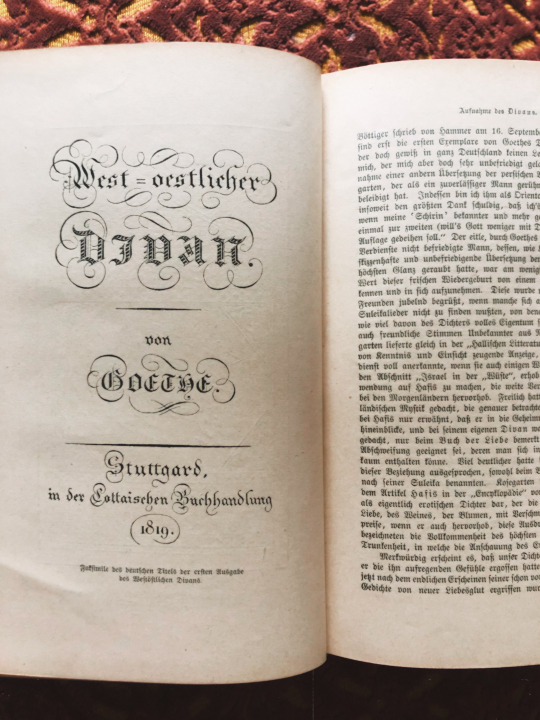

The "East-Western Diwan" is the last great cycle of poetry Goethe has wrote, his interest for Persian poetry arised in the time of the Rheinbund. It can be traced, that this period of time disillusioned him, the diving into another time and continent is essential for escapism, but as Goethe and his field of interest and curiosity is as deep as wide, he must felt like thrown like a freed bird into new heavenly realms. The "Diwan Atmosphere" was created by reading several works and taking in Oriental elements. So we can find "Madschnun and Leila" interwoven in the heart-shaking correspondence between Suleika and Hatem in the "Book Suleika". Expressions of the Dervish Hafis of Shiraz can be found, Tarafas, Labid (Prophet Mohammad called him the poet, who said the most true words; Labid converted to Islam and wrote eologies, but it is said, that he stopped practicing ?), Zoheir, Saadi and Hafez. Saadi was also known as a sheik and was called "Poet-King" (or King-Poet, if you like :P) and if we would compare the structure of the poems, it is more likely, that Goethe imitated Saadi, rather than Hafez.

Goethe is playing wonderfully with expressions, merging wine and tears, praising the dust of the lover as better than safran and comparing the loved one to a drop of water and the lyrical-I as desert sand. Numerology is emphasising the cultural background, drawing a link between the poet and the priest, pairing mystics and religion into ecstatic relief. This wonderful work is a gift, for everyone, who sometimes had the feeling of getting ripped apart by two forces. It feels like the made-up gap between Europa and Asia is nothing but a fiction, like a forgotten song of our cultural cradle. Let us share the pomegranates of our culture, let us nourish from unkown fruits to break our borders, to sharpen our discernment, to truely lift our feet and recognize the extraordinary.

#antiquarian book#world literature#19th century literature#book#reading#Goethe#East-Western Diwan#Östwestlicher Divan#cultural bridge#Persian poetry#Arabian culture#Oriental#Orient#poetry#poets#German poet#Johann Wolfgang von Goethe#1878#old book#antiquarian
10 notes
·
View notes
Text
Discover 10 More Underrated Coastal Towns in South Africa

Exploring South Africa’s diverse coastline reveals a mosaic of tranquil retreats and vibrant towns. These ten additional underrated coastal towns in South Africa, from the serene beaches of Witsand in the Western Cape where the Breede River meets the sea, to the historic charm of Port Nolloth on the untamed northwest coast, each offer a unique blend of natural beauty and cultural richness.
Whether you're drawn to the relaxed fishing villages of Port Nolloth or the migratory whales of Witsand, these locations provide remarkable experiences off the beaten path. Join us as we uncover these lesser-known coastal gems.
1. Witsand, Western Cape
Located at the estuary of the Breede River, Witsand is a serene coastal retreat known for its immaculate sandy beaches and the rich Cape Fynbos ecosystem. Dubbed the “Whale Nursery” of South Africa, Witsand comes alive from June to November with peak whale migration. Outdoor activities abound here, from kitesurfing and surfing to stand-up paddleboarding and fishing. This hidden gem lies off the N2 near Heidelberg, enticing travelers with its picturesque roads and historical charm.
Witsand’s history dates back to Captain Benjamin Moodie’s acquisition of the farm Westfield in 1831. Its allure as a fishing paradise began attracting vacationers in the late 1800s. Today, Witsand continues to captivate visitors with its blend of natural beauty, outdoor adventures, and rich historical legacy, offering a serene escape along South Africa’s lesser-traveled coastline.
2. Kenton-on-Sea, Eastern Cape
Nestled along South Africa s Sunshine Coast, Kenton-on-Sea boasts untouched beaches, lush hills, and pristine coastal reserves. Situated between the Bushmans and Kariega Rivers, Kenton-on-Sea is bordered by water on three sides, making it perfect for various water sports. Despite its natural beauty and popularity, Kenton-on-Sea retains a charming small-town atmosphere, enriched by its cultural diversity.
3. Glentana, Western Cape
Tucked between Mossel Bay and George on the Garden Route, Glentana offers wide sandy beaches and Fynbos-covered cliffs. This village, nestled in an old riverbed and shielded from sea winds, provides a tranquil haven. Discover hidden caves, try rock fishing, and explore the beaches for treasures like the elusive “Pansy” shell. Dolphins and whales are frequently spotted along the coastline, adding to Glentana’s allure as a sanctuary for nature lovers.
Accommodation options range from charming guest houses and self-catering cottages to scenic seaside camping spots, catering to various preferences and budgets.
4. Hondeklip Bay, Northern Cape
Located on South Africa’s rugged West Coast, Hondeklip Bay has transformed from a historic copper ore export hub into a beloved holiday destination. Positioned about 95 km southwest of Springbok, this coastal retreat offers diverse accommodations, from seaside camping to cozy self-catering chalets. Explore the picturesque coastline adorned with ancient shipwrecks, delve into the region’s natural wonders, and embark on exhilarating 4×4 excursions.
5. Zinkwazi Beach, KwaZulu-Natal
Situated on KwaZulu-Natal’s North Coast, Zinkwazi Beach is renowned for its serene lagoon created by the Zinkwazi River’s estuary. Known for its biodiversity and natural beauty, this hidden gem offers immaculate golden beaches, lush native forests, and a seven-kilometer lagoon. Beyond its breathtaking scenery, Zinkwazi Beach provides a secure haven for beachgoers with lifeguard-patrolled shorelines and activities like ferry rides and birdwatching.
6. Mtunzini, KwaZulu-Natal
Mtunzini, nestled along KwaZulu-Natal’s coastline, offers a serene escape renowned for its natural beauty and unique wildlife. Celebrated among bird watchers for being a sanctuary for the rare palm-nut vulture, Mtunzini also boasts pristine beaches, a 9-hole golf course, and diverse accommodation options. Surfers favor its waves along the North Coast, adding to Mtunzini’s appeal for both relaxation and adventure.
7. Morgans Bay, Eastern Cape
Morgan Bay, tucked away in the Amathole District Municipality, is a hidden treasure on the Wild Coast. Named after A.F. Morgan in 1822, this village attracts visitors with its breathtaking beach, peaceful estuary, and striking sea cliffs. Adventurers and nature lovers flock here for activities like sandboarding, hiking, and exploring historic sites.
Morgan Bay offers a range of recreational pursuits, from beach sports to exploring the Inchara river estuary and engaging in township tours. The nearby Cape Morgan Nature Reserve enhances its appeal with coastal forests and hiking trails, making it an ideal destination for relaxation and adventure.
8. Haga Haga, Eastern Cape
Haga Haga, located on the Eastern Cape Wild Coast, is known for its peace and scenic splendor. Approximately 70 kilometers north of East London, this vacation village offers pristine landscapes home to endangered native species. Activities include swimming, rock and surf fishing, golf, tennis, and horse riding, making it a haven for nature lovers.
9. Port Nolloth, Northern Cape
Port Nolloth, a peaceful town and domestic seaport in the Namaqualand region, is rich in history and maritime legacy. Today, it thrives on fishing and small-boat tourism, with attractions like the Namaqua Flower Route and local cultural experiences. McDougalls Bay offers pristine beaches and calm waters for activities like swimming and kayaking, while local guides provide insights into the area’s rich history.
10. Brenton-on-Sea, Western Cape
Located 15 kilometers west of Knysna on the Garden Route, Brenton-on-Sea is a serene seaside retreat named after Sir Jahleel Brenton. Nestled in the Goukamma Nature Reserve, this area boasts expansive golden beaches, stunning whale and dolphin watching spots, and paragliding adventures. With various accommodation options, Brenton-on-Sea ensures a comfortable and memorable stay amidst its picturesque coastal scenery.
These underrated coastal towns offer unique experiences and natural beauty, making them perfect destinations for those seeking adventure and tranquility off the beaten path in South Africa.
#UnderratedSouthAfrica
#CoastalGems
#HiddenSouthAfrica
#SouthAfricaTravel
#ExploreSA#SAcoast
#TravelSouthAfrica
#DiscoverSA
#SecretBeaches
#SACoastalTowns
#HiddenSouthAfrica
#SouthAfricaTravel
#ExploreSA#SAcoast
#TravelSouthAfrica
#DiscoverSA
2 notes
·
View notes
Text
As Andrew Haigh's upcoming film All of Us Strangers, begins screening at an ever expanding list of film festivals, beyond the three featured on the official poster, Telluride Film Festival, New York Film Festival and BFI London Film Festival.
I am attempting to maintain an up to date list, in chronological order, (last updated Dec 14th, 2023)

All the details about the festivals, links to where/when to get tickets are under the cut.
Athens International Film Festival Sept 27- Oct 9
Beyond Fest (Los Angeles, its West Coast Premiere) Sept 26-Oct 10
Hamptons International Film Festival Oct 5-12
Festival do Rio (Rio de Janeiro International Film Festival) Oct 5-15
HIFF: Heartland International Film Festival (Indianapolis, IN) Oct 5-15
FFG (Film Fest Gent, Belgium) Oct 10-21
Chicago International Film Festival Oct 11-22
Seattle Queer Film Festival (opening night gala) Oct 12-22
Newfest (New York LGBTQ+ Film Festival, Closing Night film) Oct 12-24
FILMEKIMI iKSV Oct 13-22 (Istanbul) Oct 20-22 (Izmir)
BIFF: Bergen International Film Festival Oct 18-26
Adelaide Film Festival (Australia) Oct 18-29
Alice nella Città (independent section of the Rome Film Festival) Oct 18-29
Middleburg Film Festival (VA) Oct 19-22
Cambridge Film Festival Oct 19-26
FFCGN: Film Festival Cologne (Germany) Oct 19-26
Twin Cities Film Festival (Minneapolis/St Paul MN ) Oct 19-28
Film Bath Festival Oct 19-29 (booking now)
Outshine LGBTQ+ Film Festival (Ft Lauderdale, FL) Oct 19-29
Viennale (Vienna Film Festival) Oct 19-31
FICM (Festival Internacional de Cine de Morelia) Oct 20-29
Montclair Film Festival (NJ) Oct 20-29
SCAD Savannah Film Festival (GA) Oct 21-28
SEMINCI (Semana Internacional de Cine de Valladolid, ES) Oct 21-28
AFI Fest: American Film Institute (Los Angeles, CA) Oct 25-29
VAFF:Virginia Film Festival (Charlottesville) Oct 25-29
TIFF-jp (Tokyo International Film Festival) Oct 23 - Nov 1
AFF (Austin Film Festival and screenwriters conference) Oct 26-Nov 2
BIFF: Brisbane International Film Festival Oct 26 - Nov 5
LIFF (Leiden International Film Festival, NL ) Oct 26 - Nov 5
Miami Film Festival GEMS Nov 2 - 5
Belfast Film Festival (opening night gala) Nov 2-11
Inverness Film Festival Nov 3-9
Denver Film Festival Nov 3-12
Leeds International Film Festival Nov 3-19
PÖFF (Pimedate Ööde filmifestival): Tallinn Black Nights Film Festival (Estonia) Nov 3-19
ZFF: Zagreb Film Festival (Croatia) Nov 6-12
Cornwall Film Festival (opening night) Nov 6-19
LIFFe: Ljubljana International Film Festival (Slovenia) Nov 8-19
Stockholm International Film Festival Nov 8-19
MQFF: Melbourne Queer Film Festival Nov 9-19
SLIFF: St Louis International Film Festival (closing night) Nov 9-19
Cork International Film Festival (Ireland) Nov 9-26
TGHFF: Taipei Golden Horse International Film Festival Nov 9-26
CINECITY: Brighton Film Festival (closing night) Nov 10-19
EnergaCAMERIMAGE International Film Festival (Toruń, Poland) Nov 11-18
IFFMH: International Film Festival Mannheim Heidelberg Nov 16-26
QCINEMA International Film Festival (Quezon City, Philippines) Nov 17-26
Chéries-Chéris: Festival du Film LGBTQI & +++ de Paris Nov 18-28
SGIFF: Singapore International Film Festival Nov 30- Dec 10
Around the World in 14 Films: Berlin Independent Film Festival (closing night) Dec 1-9
SIFF: Sonoma Awards Buzz Screening Dec 12
Festival Univerciné, Britannique (Nantes) Dec 12-14
AOUS Fundraiser screening to support HIFF : Love & Anarchy (Finland) Dec 14
Les Arcs Film Festival Dec 16-23
TLVFEST: Tel Aviv International LGBTQ+ Film Festival Dec 21-31
Athens International Film Festival 🇬🇷
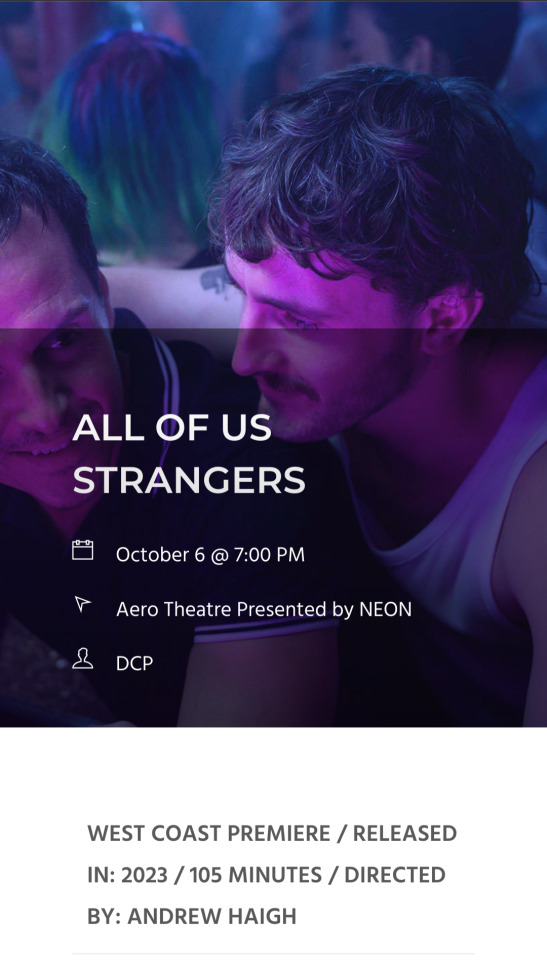
Beyondfest (co-presented by Outfest) Los Angeles, CA 🇺🇸
HIFF33 Hamptons 🇺🇸 International Film Festival
Festival do Rio: Rio de Janeiro International Film Festival 🇧🇷
HIFF33 Heartland International Film Festival Indianapolis 🇺🇸
Film Fest Gent 🇧🇪
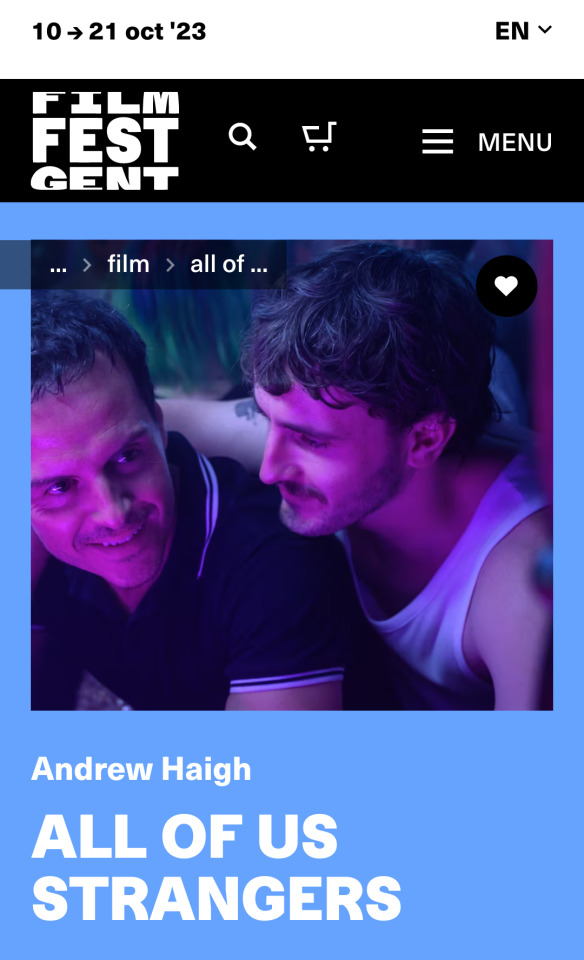
Chicago International Film Festival 🇺🇸
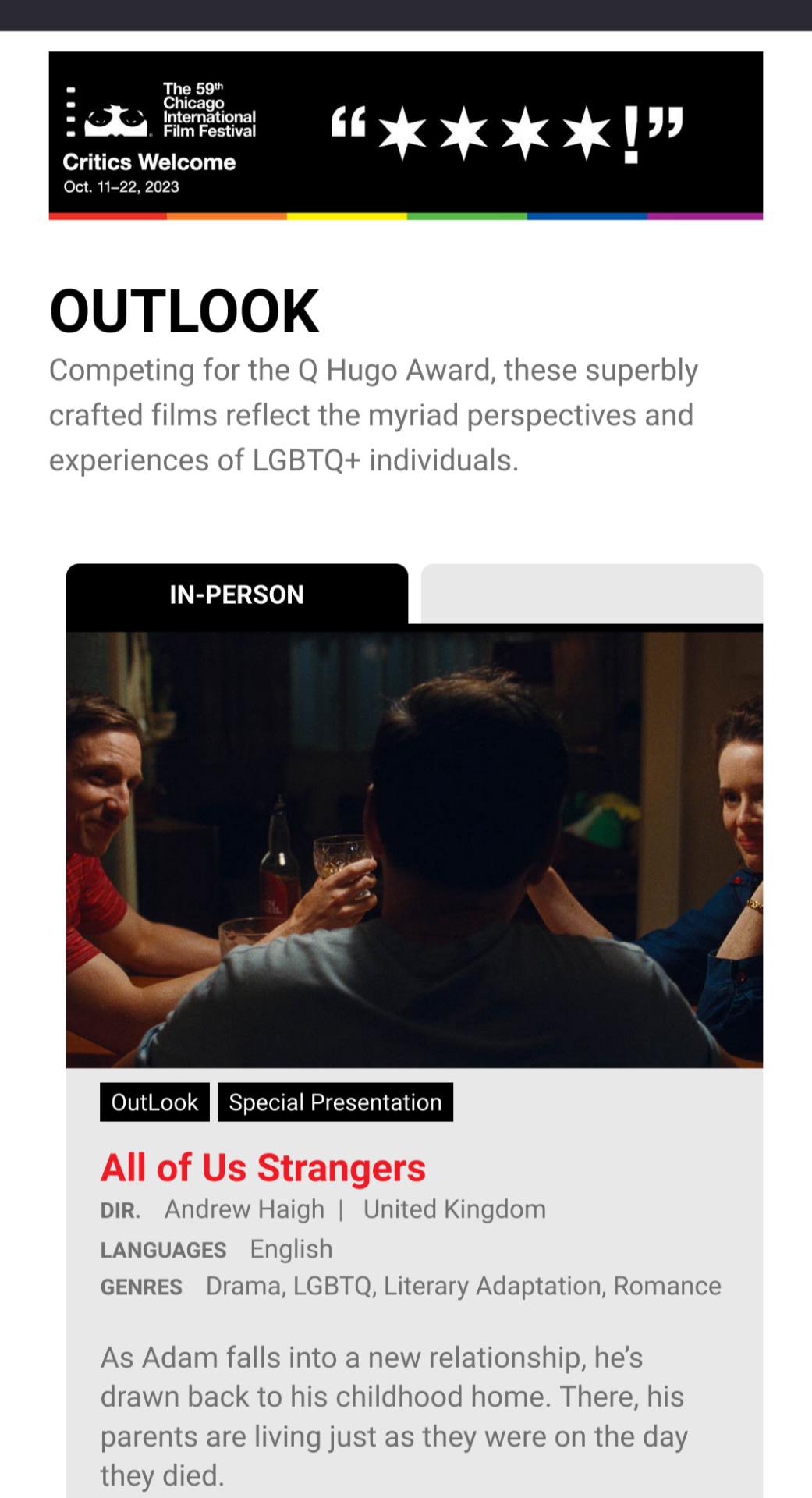
All of Us Strangers was added to the recently released lineup for The Chicago International Film Festival (the longest running competitive international film festival in North America), as an entry in their Outlook Competition.
🎟️Tickets
Seattle Queer Film Festival 🇺🇸

Seattle Queer Film Festival will open on Thursday October 12th at The SIFF Egyptian with the West Coast Premiere of Andrew Haigh’s critically acclaimed new drama, ALL OF US STRANGERS starring Andrew Scott (Fleabag) Claire Foy (The Queen), and Paul Mescal (Aftersun).
Newfest: New York 🇺🇸

FILMEKIMI 🇹🇷
BIFF: Bergen International Film Festival Oct 🇳🇴
The lineup for BIFF 2023 is complete and ticket sales are open! Screening schedule and ticket sales from October 5th!
AFF: Adelaide Film Festival 🇦🇺
Alice nella Città 🇮🇹
The "surprise movie 3" closing Alice nella Città is Andrew Haigh's Estranei (All of Us Strangers), the film's Italian premiere, October 29th.

Middleburg Film Festival, Virginia 🇺🇸
🐎🐎🐎🐎🐎🐎
Cambridge Film Festival 19th - 26th October 🇬🇧
FFCGN: Film Festival Cologne 🇩🇪
Twin Cities Film Festival, Minneapolis/ St Paul Minnesota 🇺🇸
Film Bath Festival 🇬🇧

Outshine LGBTQ+ Film Festival 🇺🇸
Viennale: Vienna Film Festival 🇦🇹
This year's Viennale will take place from October 19 to October 31. The complete program of this year's festival edition will be published online on October 10, 8 pm. here on this website. Tickets are available from October 14, 10 am.
FICM: Morelia Film Fest 🇲🇽
Montclair Film Festival, New Jersey 🇺🇸
SCAD Savannah Film Festival, Georgia 🇺🇸
The largest university-run film festival in the world, presenting competition film screenings, gala premieres, special screenings, workshops, and panels with lauded industry guests, award-winning professionals, and emerging student filmmakers.
SEMINCI 68: Semana Internacional de Cine de Valladolid 🇪🇸
AFI Fest: American Film Institute (Los Angeles, CA)🇺🇸
VAFF:Virginia Film Festival (Charlottesville) 🇺🇸
TIFF-JP: Tokyo 🇯🇵 International Film Festival
AFF: Austin Film Festival🇺🇸
October 26 – November 2 We are proud to announce ALL OF US STRANGERS as one of the premiere films at #AFF30! Join us at the Festival to witness a journey that transcends time, love, and even death! Purchase your badge here
BIFF: Brisbane International Film Festival🇦🇺
LIFF:Leiden International Film Festival, Netherlands 🇳🇱
Miami Film Festival GEMS 🇺🇸 "the jewels of the fall season"

Inverness Film Festival Scotland 🏴 Nov 3-9
Denver Film Festival: Denver Colorado 🇺🇸
Andrew Haigh’s new film, All of Us Strangers will screen on Friday, Nov. 10th at the Denver Botanic Gardens. Includes a post-film conversation and award presentation to director Andrew Haigh. Pre-reception included in ticket price. Reception begins at 6pm. Screening begins at 7pm..
Leeds International Film Festival 🇬🇧
PÖFF: Tallinn Black Nights Film Festival 🇪🇪
Local title:Kõik me võõrad
Title in Russian: Незнакомцы
ZFF: Zagreb Film Festival (Croatia) 🇭🇷
Cornwall Film Festival 🇬🇧
LIFFe: Ljubljana International Film Festival Slovenian 🇸🇮
Stockholm International Film Festival 🇸🇪
MQFF: Melbourne Queer Film Festival🇦🇺
SLIFF: St Louis International Film Festival 🇺🇸
Highlighting the lives of the LGBTQ+ community, SLIFF’s QFest Spotlight Film, “All of Us Strangers,” from Searchlight Pictures, the critically acclaimed romantic drama written and directed by Andrew Haigh, starring Andrew Scott, Paul Mescal, Jamie Bell, and Claire Foy, will close the festival on 11/19
Cork International Film Festival 🇮🇪
Scheduled: Sun 19 November Showtime: 20:30
Venue: The Everyman
MacCurtain Street, Cork
Taipei Golden Horse International Film Festival 🇹🇼
CINECITY: Brighton Film Festival 🇬🇧
CLOSING NIGHT: Nov 19 Andrew Haigh's All of Us Strangers, Duke of York's Picturehouse. The full programme will be announced on Friday 20th October - when tickets will also go on sale.
EnergaCAMERIMAGE 31st Edition of The International Film Festival Of the Art of Cinematography, Toruń 🇵🇱
a great international feast of cinema
Excellent movies, outstanding filmmakers, meetings, seminars, workshops
Presentations of modern technologies and film equipment
Remarkable documentary films and terrific music videos
Exceptional atmosphere and unforgettable experience
Unique tribute to the 10th muse
🎟️Passes
IFFMH: International Film Festival Mannheim Heidelberg 🇩🇪
QCINEMA International Film Festival 🇵🇭
Chéries-Chéris: Festival du Film LGBTQI & +++ de Paris🇫🇷
Ouverture : @CheriesCheris 2023 Sans jamais nous connaître (All Of Us Strangers) de Andrew Haigh Mardi 21 Novembre au MK2 Bibliothèque Translated from French by Opening Film: @CheriesCheris 2023 Without ever knowing us (All Of Us Strangers) by Andrew Haigh Tuesday November 21 at MK2 Library
SGIFF: Singapore International Film Festival 🇸🇬
Around the World in 14 Films, Berlin 🇩🇪
🎟️Tickets available Nov 14
The Berlin premiere of “All of Us Strangers” by British director Andrew Haigh (“45 Years”) marks the celebratory conclusion of the 18th edition of AROUND THE WORLD IN 14 FILMS on Saturday, December 9th, 2023. Only at the end of August 2023 Andrew Haigh's “All of Us Strangers” celebrated its world premiere at the American Telluride Film Festival. The 18th World Cinema Festival presents the “surreal romance” (Vogue) in its “Closing Night”. The on-screen appearances of Andrew Scott and Paul Mescal, two of Ireland's hottest actors, are likely to provide star power. Lead actor Andrew Scott shone in his role as Moriarty in the BBC cult series “Sherlock” and other appearances in “James Bond 007: Specter” and “Fleabag”. Paul Mescal, star of the British series "Normal People", attracted worldwide attention with his moving performance in the independent hit "Aftersun". Director Andrew Haigh will also have fond memories for Berliners: his masterpiece “45 Years” won the Silver Bear at the Berlinale in 2015, which the leading actors Charlotte Rampling and Tom Courtenay received.
SIFF: Awards Buzz Screening 🇺🇸
🎟️Tickets

Festival Univerciné Britannique, Nantes 🇫🇷
🎟️Tickets
Save HIFF Love & Anarchy 🇫🇮
The future of HIFF – Love & Anarchy, one of Finland’s most significant film festivals, is under threat. HIFF is now calling on its audience to help. There are three types of tickets available for the support screenings, and you can support with either 25 €, 40 € or 100 €. The tickets will go on sale on 29.11.2023 at 11.00.
One of the most popular guests in the history of HIFF has been the Irish actor Andrew Scott, who visited Helsinki in 2014. It is only appropriate that we are the first in Finland to screen a film that will be one of the highlights of his career.
All of Us Strangers, directed and written by Andrew Haigh, is one of the highlights of the autumn. The film, which received top reviews at Telluride and the New York Film Festival, is a drama about loneliness, grief and a longing for love that gets under your skin.
🎟️Support screening tickets
Les Arcs Film Festival 🏔️🇫🇷
TLVFEST LGBTQ+ International Film Festival 🇮🇱 tickets 🎟️
#all of us strangers#andrew haigh#film festivals#beyondfest#newfest#aff austin film festival#andrew scott#paul mescal#claire foy#jamie bell#film bath festival
8 notes
·
View notes
Text
Deutschribing Germany
Sports
Germany ranks fourth in the Olympic Games medal count, having won 922 medals in both Summer and Winter Olympic Games since 1896. The country has hosted international sports events such as the 1936 and 1972 Summer Olympic Games in Berlin and Munich, the 1936 Winter Olympic Games in Garmisch-Partenkirchen, and the 1974 and 2006 FIFA World Cup. It will host the UEFA Euro 2024.


Soccer
Soccer is the most popular sport in Germany. The Bundesliga (“federal league”) is the top professional soccer league. Clubs such as FC Bayern Munich, Borussia Dortmund, Borussia Mönchengladbach, RB Leipzig, SV Werder Bremen, and VfB Stuttgart take part in it. The most successful team is Bayern Munich, having won thirty-two Bundesliga titles.

The German men’s national soccer team won the Olympic Games in 1976, the World Cup in 1954, 1974, 1990, and 2014 and the UEFA Euro in 1972, 1980, and 1996. The women’s national team is also a world power, having won the Olympic Games in 2016, the FIFA Women’s World Cup in 2003 and 2007 and the UEFA Women’s Euro in 1989, 1995, and 2001, making Germany the only country to have won both the men’s and women’s World Cup and European titles.

Handball
Germany, together with Denmark, is regarded as the birthplace of handball, as the first match took place in Berlin. The men’s national team has won the Olympic Games once, the IHF Wold Men’s Handball Championship three times, and the EHF Euro twice. The most successful team in the Handball-Bundesliga is THW Kiel.

Basketball
The most successful clubs in the Basketball-Bundesliga are Alba Berlin, Bayer 04 Leverkusen, Brose Bamberg, and USC Heidelberg. Notable German basketball players include Dirk Nowitzki, Elias Harris, Linda Frölich, Shawn Bradley, and Tim Ohlbrecht.
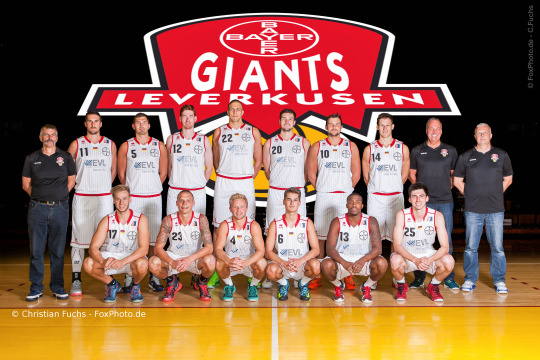
The German men’s national basketball team has won only one international gold medal at the 1993 Eurobasket, as well as one silver and two bronze medals. The women’s national team has won only one medal in international competitions, a bronze one at the 1997 Eurobasket.
Ice hockey
Germany has hosted the Ice Hockey World Championships seven times and the Ice Hockey European Championships four times. The men’s national team has never won an international competition, but has won seven silver medals, and is ranked seventh in the world.

Motorsports
Germany is one of the leading motorsports countries, having manufactured countless race winning cars. Notable Formula One champions include Michael Schumacher, Nico Rosberg, and Sebastian Vettel.
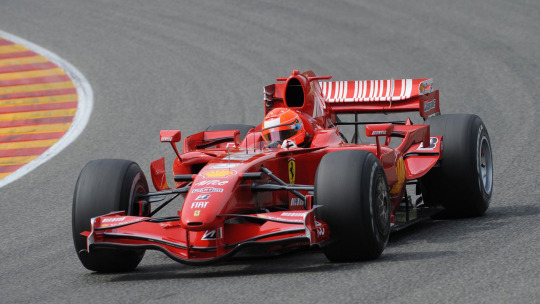
The country hosts the Deutsche Tourenwagen Masters, a sports car racing series based in Germany, with rounds in other European countries. Since 1995, only German car brands are allowed to compete.
Winter sports
Germany is also very successful in winter sports, being the only country in the world to have four bobsleigh, luge, and skeleton tracks. It has won more medals in bobsledding than any other country in the world, if those won by East and West Germany are included.

The country also dominates biathlon, luge, and skeleton thanks to athletes such as Sven Fischer and Uschi Disl in biathlon, Felix Loch and Natalie Geiseberger in luge, and Anja Huber and Kerstin Jürgens in skeleton.
Notable skiers include Tobias Angerer in cross-country skiing, Martin Schmitt in ski jumping, Eric Frenzel in Nordic combined, and Katja Seizinger in alpine skiing. Claudia Pechstein is renowned in speed skating and Katarina Witt in figure skating.

Tennis
The two most successful German tennis players of all time are Boris Becker and Steffi Graf. The former won six Grand Slam titles, and the latter won twenty-two, becoming the only tennis player to win all four Grand Slam titles and the Olympic gold medal in the same year.

Cycling
Jan Ullrich is one of the greatest riders, together with Tony Martin in individual time trial races and André Greipel among road sprinters. Germany has hosted the start of the Tour de France four times.

7 notes
·
View notes
Quote
“Si piensas que estás vencido, ya lo estás, si piensas que no te atreves, no lo harás, si piensas que te gustaría ganar, pero no puedes, es casi seguro que no lo lograrás”
Christiaan Barnard

Christiaan Neethling Barnard fue un médico cardiólogo cirujano y escritor sudafricano nacido en Beafuort West en noviembre de 1922, pasó a la historia por haber sido el primero en realizar un trasplante de corazón humano del que se tiene constancia.
Fue hijo de un misionero de la iglesia reformada de Holanda. Su padre tenía escasos ingresos y gracias a su posición en la Iglesia pudo costear la educación de sus hijos.
Uno de los cuatro hermanos de Christiaan murió a la edad de 5 años de una enfermedad cardiaca, lo que tal vez pudo haberlo impulsado a estudiar medicina y a especializarse en este campo.
Cursó medicina en la Universidad del Cabo en donde se graduó en 1953, iniciando su carrera como médico cirujano en el hospital Groote Schuur, en donde su hermano era el jefe del equipo de trasplantes.
Ingresó mediante una beca en la Universidad estadounidense de Minnesota en donde obtuvo el título de doctor especialista en cardiología en 1958.
Fue un alumno aventajado del prestigioso doctor Owen H. Wangesteen quien lo introdujo en la ciencia cardiovascular y por otra parte los estudios realizados por el reconocido pionero de la cirugía cardiaca en la Universidad de Stanford el Doctor Norman Shumway, fue quien lo familiarizó con la técnica de trasplantes de corazón con animales.
A su regreso a Sudáfrica Barnard practicó el trasplante de corazón con animales y en 1962 fue nombrado jefe de cirugía torácica en el mismo hospital Groote Schuur en donde se doctoró.
El 3 de diciembre de 1967, Barnard realizó el primer trasplante de corazón en una persona, la donante se llamaba Denise Darvall, una joven oficinista de 25 años, quien falleció al ser atropellada y el receptor fue Louis Washkansky un comerciante de 56 años desahuciado por un irreversible problema cardiaco y una diabetes aguda.
La operación fue llevada a cabo con la asistencia de 20 cirujanos bajo la dirección de Barnard y tuvo una duración de 20 horas.
Cuando el paciente se despertó declaró que se sentía mucho mejor con el nuevo corazón, aunque 18 días después del trasplante, el receptor murió por una neumonía.
En enero de 1968, un segundo trasplante se realizó viviendo el receptor prácticamente año y medio.
Durante la década de los 70, Barnard continuó realizando trasplantes con relativo éxito. Para 1975 su fama empezaba a declinar derivado de sus constantes fracasos. Realizó alrededor de 140 trasplantes, entre ellos el del corazón de un mandril que fue implantó en una enferma de 25 años quien murió a las pocas horas.
En 1981 Barnard abandonó la practica de su profesión derivado de problemas artríticos dedicándose a la publicación y difusión de sus libros.
A partir de 1987 se dedicó a la investigación médica y dirección de equipos en el Instituto Max Planck y la Universidad de Heidelberg en Alemania.
Barnard murió en Chipre a la edad de 78 años víctima de un ataque de asma.
Fuente: Wikipedia y nutsai.blogspot.com
#frases#citas de reflexion#citas de la vida#cientificos#medicos#sudáfrica#frases de escritores#citas de escritores#Escritores
14 notes
·
View notes